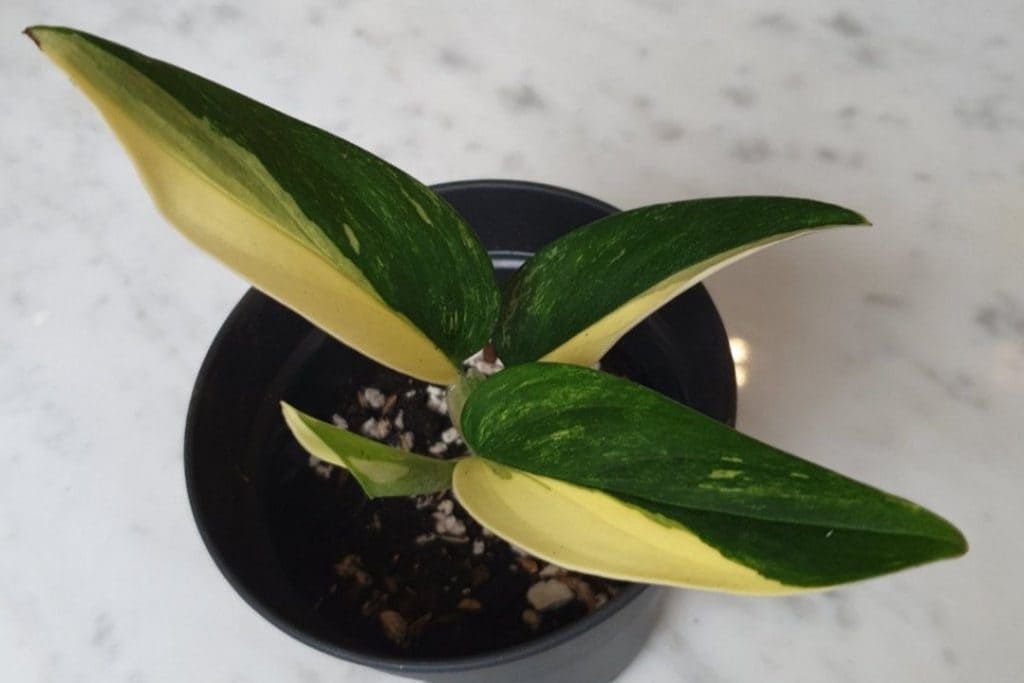I’ll never forget the first time I spotted a Monstera Standleyana at a specialty plant shop. Unlike its famous cousin with the iconic holes, this plant caught my eye with its sleek, elongated leaves showcasing splashes of creamy white variegation against deep green. The owner called it “Philodendron Cobra,” and I was immediately smitten.
That was three years ago, and since bringing one home, it’s become one of the most rewarding plants in my collection—beautiful, relatively low-maintenance, and full of character.
Whether you’re considering adding this striking plant to your collection or looking to improve care for one you already have, this comprehensive guide will cover everything you need to know about the Monstera Standleyana, from its origins and varieties to detailed care instructions and troubleshooting tips.
Read The Philodendron Imperial Red Care Guide: Growing Tips & Care Instructions
What Exactly Is Monstera Standleyana?
First, let’s clear up the name confusion:
Despite being commonly sold as “Philodendron Cobra” or “Philodendron Standleyana,” this plant is botanically a Monstera, not a Philodendron. Both genera belong to the Araceae family, and they were historically classified together, which explains the persistent confusion. The correct scientific name is Monstera Standleyana.
If you’re wondering about the pronunciation, it’s: Mon-STAIR-uh stan-DLEE-uh-nuh.
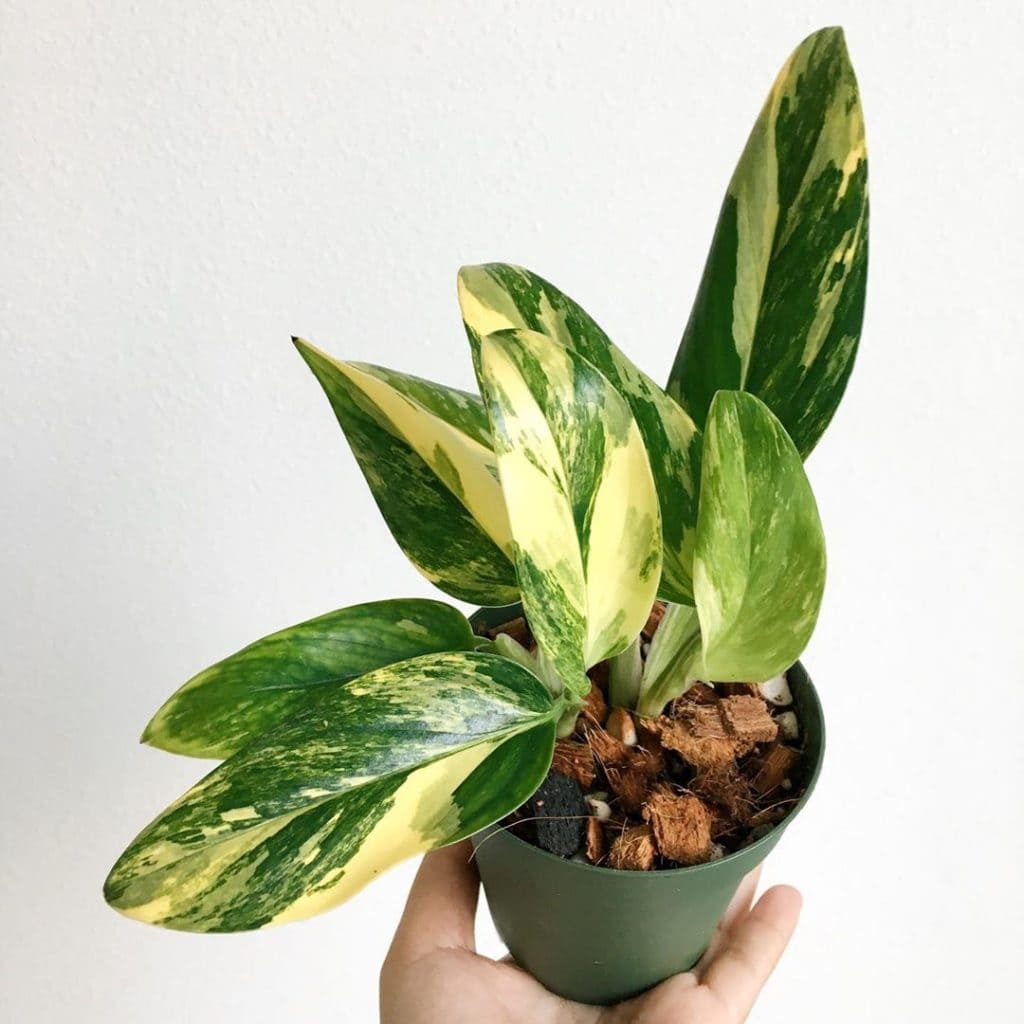
Origins and Natural Habitat
Monstera Standleyana is native to the tropical rainforests of Central America, particularly Costa Rica, Panama, and Honduras.
In its natural environment, it grows as a climbing vine, using aerial roots to attach to trees and climb upward toward filtered sunlight. This climbing habit is important to understand when creating the ideal growing conditions in your home.
Varieties and Cultivars
There are several varieties of Monstera Standleyana available, each with distinctive characteristics:
- Standard Monstera Standleyana – Features dark green, narrow leaves with occasional white or cream variegated splashes.
- Monstera Standleyana Albo Variegata – This variety has more pronounced white variegation, sometimes forming large sections or even half-moon patterns on leaves.
- Monstera Standleyana Aurea – Instead of white markings, this variety displays yellow or lime-green variegation.
In my experience, the standard variety is the most commonly available and typically the most affordable, while the Albo and Aurea varieties command higher prices due to their more dramatic variegation patterns.
Explore 53 Silver and Gray Foliage Plants for Stunning Gardens
Appearance and Growth Characteristics
Leaf Structure and Texture
Unlike many other Monstera species, Standleyana doesn’t develop fenestrations (holes or splits) in its leaves, despite sometimes being called the “Five Holes Plant.” The leaves are:
- Elongated and lance-shaped, reaching 6-8 inches in length
- Thick and leathery with a glossy surface
- Dark green with varying degrees of variegation
- Arranged alternately along slender vines
The texture of these leaves reminds me most of Scindapsus plants—they have that same substantial thickness that makes them fairly drought-tolerant and gives them a luxurious feel.
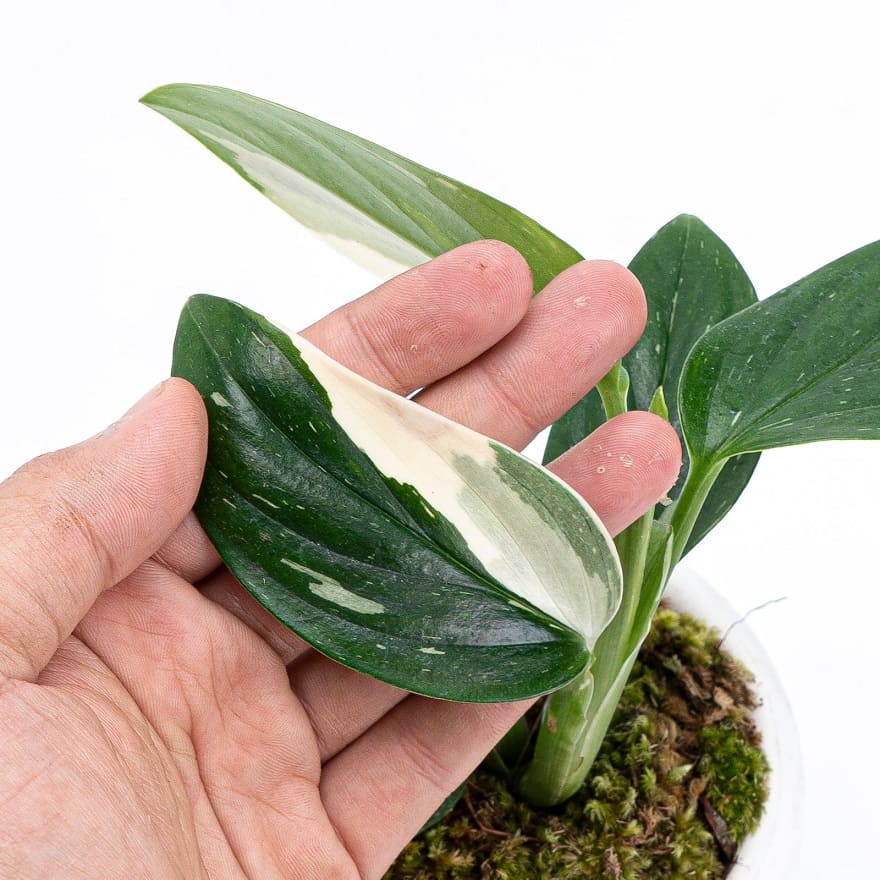
Growth Habit
Monstera Standleyana is a climbing vine that can be grown in several ways:
- Climbing – When provided with a moss pole, coir totem, or trellis, the plant will grow upward, developing its distinctive “cobra” appearance as mature leaves extend horizontally from the upright stem.
- Trailing – Without support, vines will cascade downward, making it suitable for hanging baskets or high shelves.
- Tabletop – Young plants with multiple vines in one pot often have a bushier, more compact appearance.
In my home, I’ve experimented with both methods. Initially, I allowed my plant to trail across a bookshelf, but as it grew larger, I trained it up a moss pole, which resulted in larger leaves and more dramatic growth.
Comprehensive Care Guide
Light Requirements
One of the things I appreciate most about Monstera Standleyana is its adaptability to different lighting conditions. Here’s what I’ve found works best:
- Ideal conditions: Bright, indirect light. A spot within 3-5 feet of an east or west-facing window is perfect.
- Can tolerate: Medium light (5-6 feet from a window) and brief periods of morning or evening direct sunlight.
- Avoid: Low light conditions and intense, direct sunlight during midday hours.
If your plant isn’t getting enough light, you might notice “runners”—long stems with little to no leaves that stretch toward light sources. If this happens, prune back the bare stems and move your plant to a brighter location.
Pro tip: These plants are dust magnets! The glossy, dark leaves show dust easily, so I’ve made it a habit to gently wipe the leaves with a damp cloth every few weeks. This not only keeps the plant looking its best but also improves its ability to photosynthesize efficiently.
Explore The Best Air-Purifying Indoor Plants That Thrive Without Direct Sunlight
Watering Needs
Monstera Standleyana prefers consistent moisture but can quickly succumb to root rot if overwatered. Here’s my watering approach:
- Allow the top 2-3 inches of soil to dry out completely between waterings.
- Water thoroughly until water flows from the drainage holes.
- Empty any excess water from the saucer to prevent soggy conditions.
- Reduce watering frequency during winter or periods of slower growth.
Signs of improper watering include:
- Underwatering: Subtle drooping of leaves and dry soil.
- Overwatering: “Crying leaves” (water droplets forming on leaf edges), yellowing leaves, and soggy soil.
I’ve found bottom watering particularly effective for this plant. Simply place the pot in a container of water for 15-20 minutes, allowing the soil to absorb moisture from below, then let any excess water drain completely.
Soil Composition
The right soil is crucial for Monstera Standleyana’s health, as it needs a balance of moisture retention and drainage. My personal recipe includes:
- 2 parts high-quality, peat-free potting mix
- 1 part orchid bark or coconut chips
- 1 part perlite, pumice, or lava rock
This mixture provides the aeration and drainage these plants need while still retaining enough moisture for healthy growth. If you prefer a simpler approach, any well-draining aroid mix will work well.
Temperature and Humidity
Coming from tropical regions, Monstera Standleyana thrives in warm conditions:
- Ideal temperature range: 18-25°C (64-77°F)
- Minimum temperature: 10°C (50°F)
- Growth note: Will continue growing year-round if temperatures remain above 18°C (64°F)
Unlike some tropical plants, Monstera Standleyana is relatively forgiving when it comes to humidity. Average household humidity (around 40-50%) is typically sufficient, though it will appreciate higher humidity if available. If you notice brown leaf edges in very dry conditions, consider:
- Grouping with other plants
- Using a pebble tray with water
- Running a humidifier nearby during extremely dry periods
Fertilization Schedule
I’ve found that Monstera Standleyana doesn’t require heavy feeding to thrive. Here’s a simple fertilization routine:
- Growing season (spring through summer): Apply a balanced houseplant fertilizer (N-P-K ratio of 10-10-10 or similar) diluted to half strength once a month.
- Fall and winter: Reduce to once every 6-8 weeks if the plant is still producing new growth; otherwise, pause fertilization until spring.
Slow-release fertilizer pellets added during repotting can also provide a steady nutrient supply throughout the growing season.
Support and Training
As mentioned earlier, Monstera Standleyana is naturally a climbing plant. While it can grow without support, providing a climbing structure offers several benefits:
- Encourages larger, more mature leaf development
- Creates a more upright, space-efficient growth habit
- Showcases the plant’s natural growth pattern
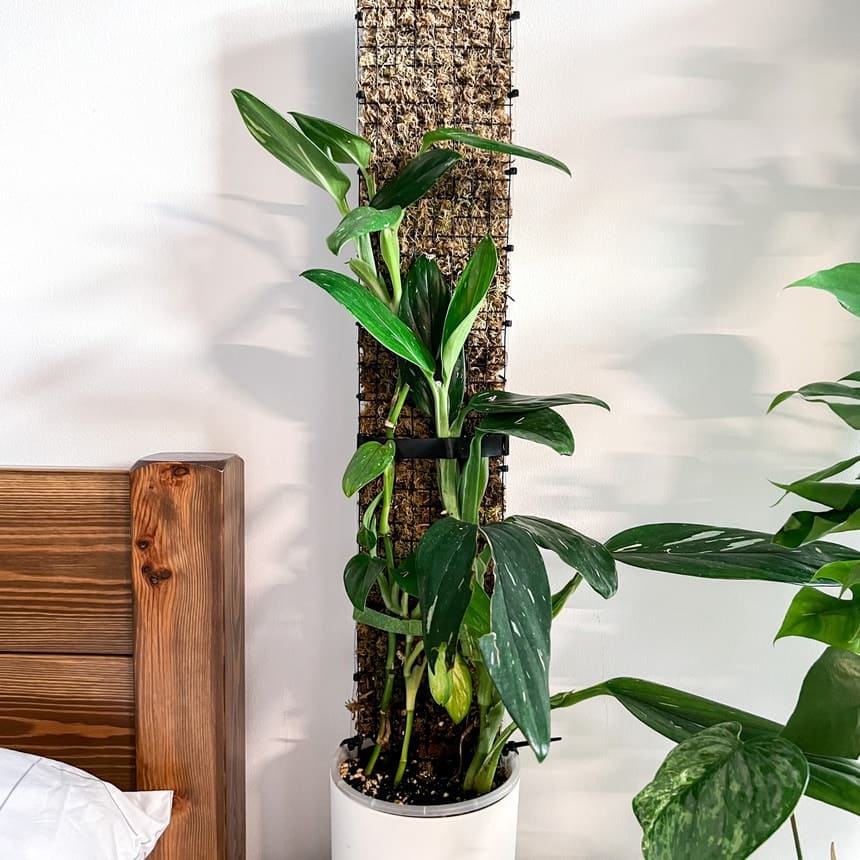
Suitable support options include:
- Moss poles (my personal preference)
- Coir totems
- Bamboo stakes
- Trellises
When attaching vines to support structures, use plant-safe ties or clips, being careful not to damage the stems. You may need to regularly guide new growth and secure it to the support, as the plant’s aerial roots aren’t as strong as those of some other Monstera species.
Find out How to Hang Plants with Ease: A Complete Beginner’s Guide
Repotting Guide
Monstera Standleyana has a moderate root growth rate and typically needs repotting every 2-3 years. Here’s my step-by-step approach:
- Timing: Repot in spring or early summer when the plant is actively growing.
- Size upgrade: Choose a pot that’s 1-2 inches larger in diameter than the current one.
- Preparation: Water the plant 1-2 days before repotting to reduce transplant shock.
- Removal: Gently remove the plant from its old pot, carefully loosening the roots.
- Root check: Inspect for any dark, mushy roots (signs of rot) and trim these away with clean scissors.
- Positioning: Place fresh soil in the new pot, position the plant at the same depth as before, and fill in around the roots.
- Post-care: Water lightly and place in a location with slightly reduced light for a week to help it adjust.
After repotting, I avoid fertilizing for at least a month to prevent potentially stressing the recovering root system.
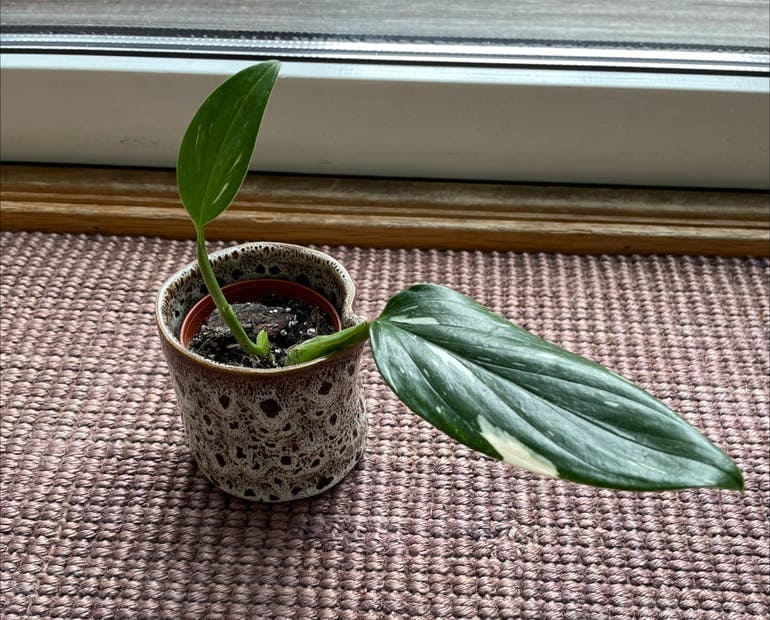
Propagation Methods
Propagating Monstera Standleyana is relatively straightforward, though I’ve found it can be slightly trickier than some other Monstera species. Here are two reliable methods I’ve used successfully:
Water Propagation
- Select a healthy stem with at least 2-3 leaves and visible nodes.
- Using clean, sharp scissors or pruning shears, cut just below a node.
- Remove any leaves that would be submerged in water.
- Place the cutting in a container of clean water, ensuring at least one node is submerged.
- Position in bright, indirect light and change the water weekly.
- Wait for roots to develop (typically 3-4 weeks in warm conditions).
- Once roots reach 1-2 inches, plant in appropriate soil mix.
Soil Propagation
- Prepare a small pot with moistened aroid soil mix.
- Take a stem cutting with 2-3 leaves and at least one node, cutting just below the node.
- Remove lower leaves, leaving the top 1-2 leaves intact.
- Dip the cut end in rooting hormone (optional but helpful).
- Create a hole in the soil and insert the cutting, ensuring the node is covered.
- Water lightly and place a clear plastic bag over the pot to create humidity (leave partially open for air circulation).
- Place in bright, indirect light and keep soil consistently moist but not soggy.
- New growth indicates successful rooting (typically within 4-6 weeks).
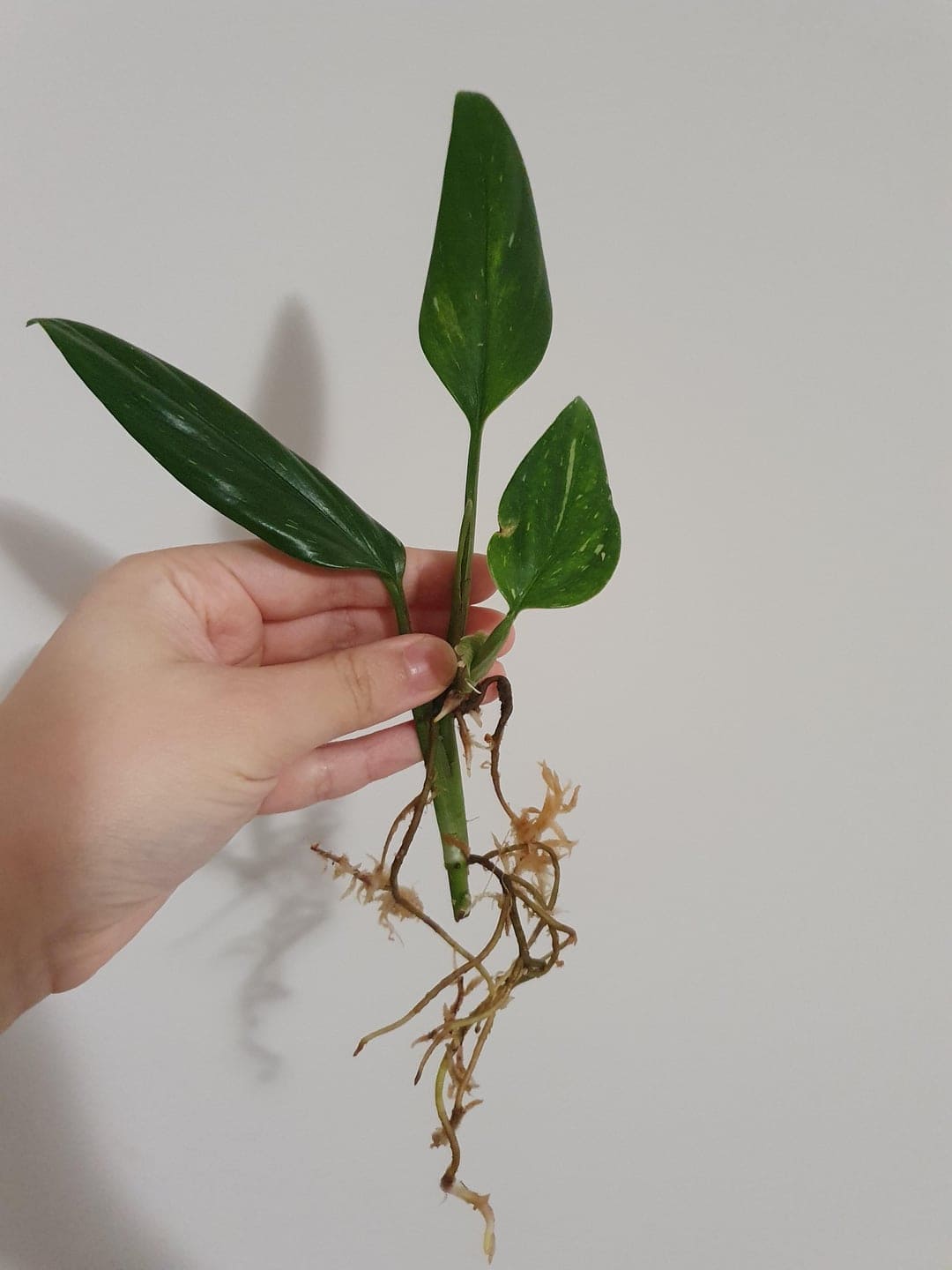
Important tip: I’ve noticed that propagation success increases significantly during warmer months. If possible, attempt propagation when ambient temperatures are consistently above 18°C (64°F).
Troubleshooting Common Issues
Leaf Problems
1. Yellowing Leaves
Possible causes and solutions:
- Overwatering: Most common cause. Allow soil to dry out more between waterings.
- Normal aging: Single yellowing leaves at the bottom of vines are natural as the plant grows. Simply remove them.
- Nutrient deficiency: If multiple leaves are yellowing and it’s been months since fertilizing, apply a balanced fertilizer.
Find out Why Are My Cucumber Leaves Turning Yellow? Top Causes & Solutions
2. Brown Leaf Edges or Tips
Possible causes and solutions:
- Low humidity: Increase humidity with a humidifier or pebble tray.
- Salt buildup: Flush the soil thoroughly with water to remove accumulated fertilizer salts.
- Variegated sections: White or cream parts of leaves naturally turn brown with age. This is normal and can’t be prevented entirely.
Learn How to Identify and Fix Brown Spots on Your Snake Plant
3. Curling Leaves
Possible causes and solutions:
- Underwatering: Check soil moisture and water if dry.
- Too much light: Move to a location with less intense light.
- Temperature stress: Ensure the plant isn’t near cold drafts or heat sources.
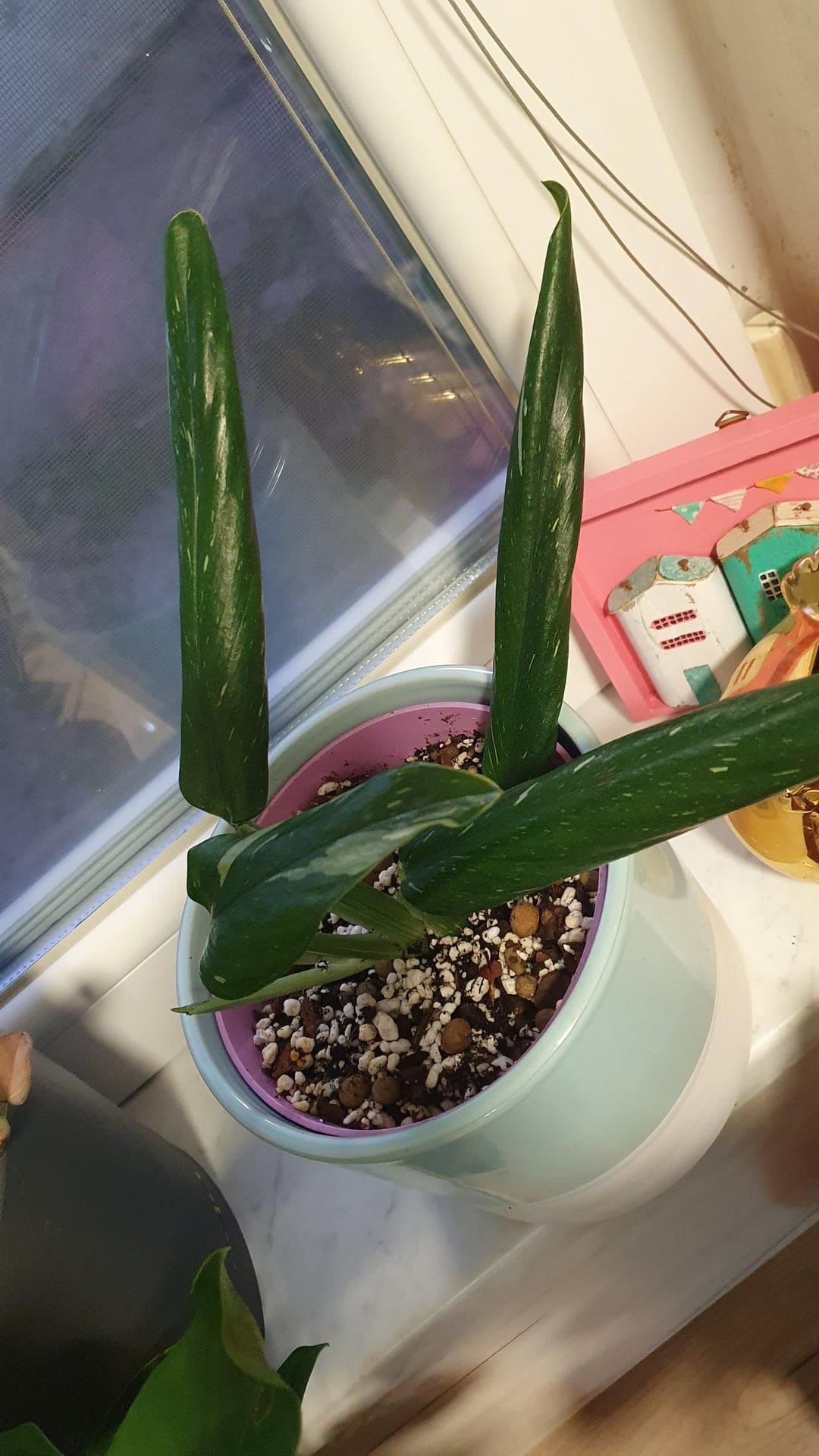
Growth Issues
1. Runners (Long Stems with Few or No Leaves)
Possible causes and solutions:
- Insufficient light: The most common cause. Move to a brighter location.
- Leggy growth: Prune back bare runners to a node to encourage bushier growth.
- Support issues: Ensure climbing varieties have adequate support structures.
2. Slow or Stunted Growth
Possible causes and solutions:
- Seasonal dormancy: Normal during fall/winter months; growth will resume in spring.
- Root bound: Check if the plant needs repotting.
- Insufficient nutrients: Apply appropriate fertilizer during the growing season.
Variegation Issues
1. Loss of Variegation
Possible causes and solutions:
- Insufficient light: Increase light exposure to encourage variegation.
- Natural variation: Some leaves may show more variegation than others; this is normal.
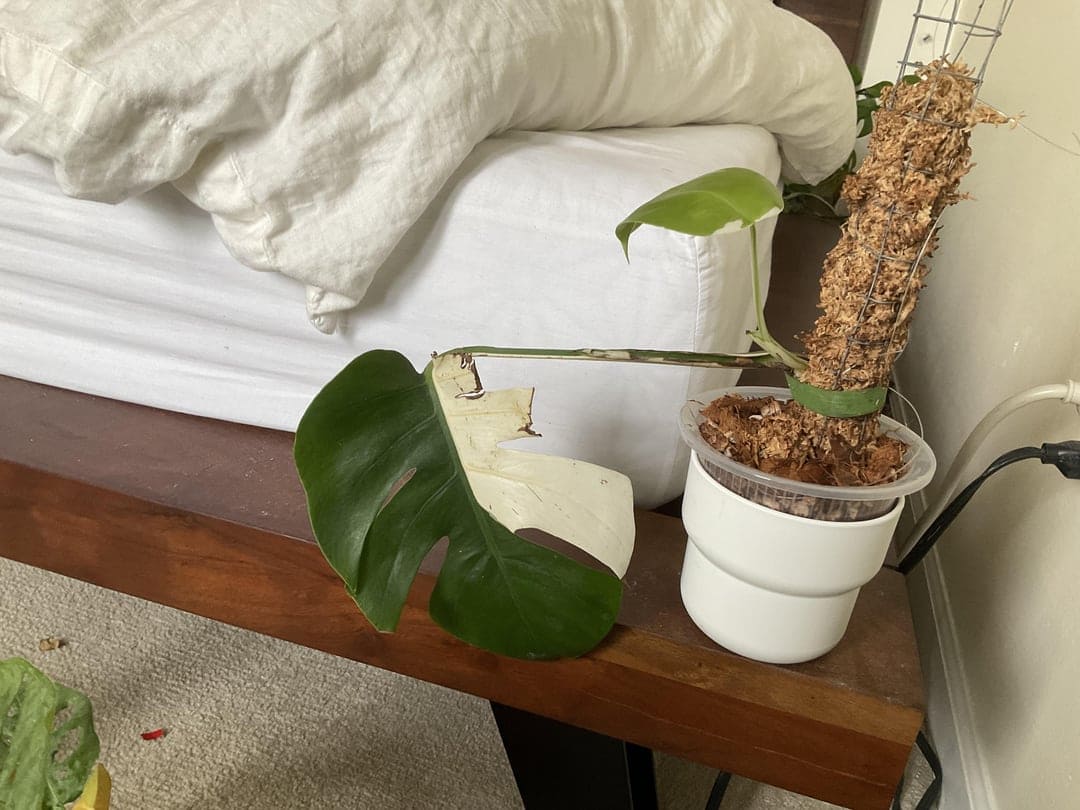
2. Browning Variegated Areas
Possible causes and solutions:
- Natural aging: White/cream areas lack chlorophyll and naturally deteriorate faster.
- Sunburn: Ensure variegated areas aren’t exposed to direct sunlight.
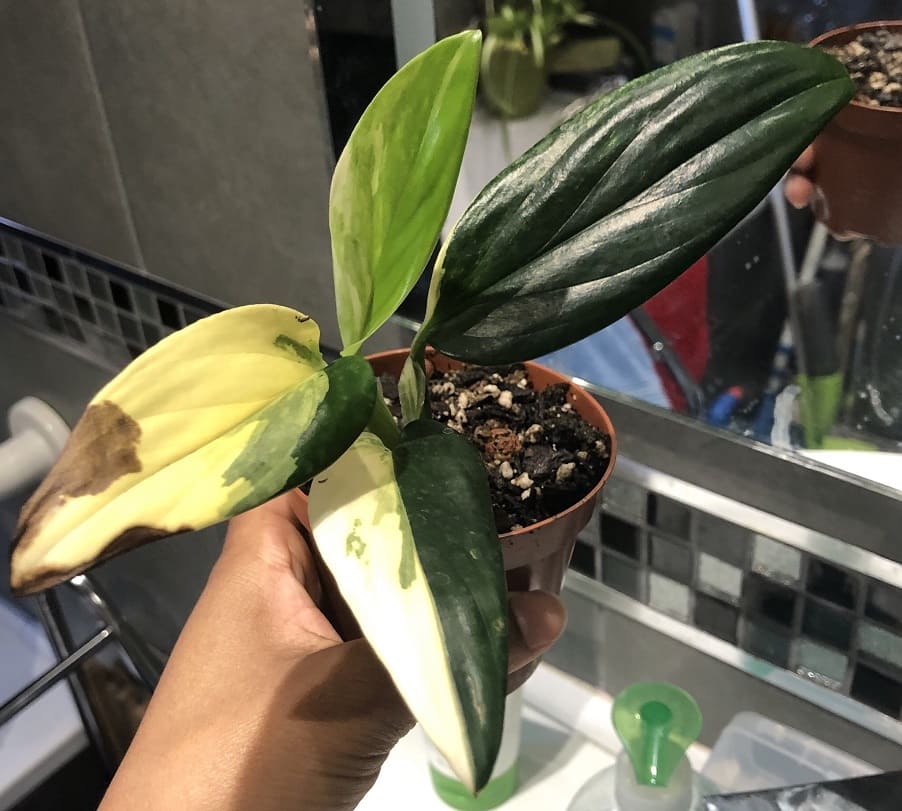
Pest Management
Monstera Standleyana can occasionally face pest issues. Here’s how to identify and treat common pests:
Spider Mites
- Signs: Fine webbing, tiny moving dots, stippled or discolored leaves.
- Treatment: Isolate plant, spray with insecticidal soap or neem oil solution, increase humidity.
Mealybugs
- Signs: White, cotton-like clusters in leaf joints and undersides.
- Treatment: Remove with alcohol-dipped cotton swab, treat with insecticidal soap or neem oil.
Scale Insects
- Signs: Brown or tan bumps on stems and leaves.
- Treatment: Scrape off gently with a soft toothbrush, apply neem oil solution.
Prevention tip: I regularly inspect my plants when watering and keep a spray bottle with diluted neem oil solution ready for early intervention at the first sign of pests.
Learn to Master Natural Pest Control: Top Organic Solutions for Your Garden
Styling and Display Ideas
One of the joys of growing Monstera Standleyana is its versatility in home décor. Here are some creative ways to showcase this beautiful plant:
As a Climbing Specimen
Mount a moss pole in a decorative pot and train the vines upward for a striking vertical accent. This works beautifully in corners or against walls, utilizing vertical space while maintaining a small footprint.
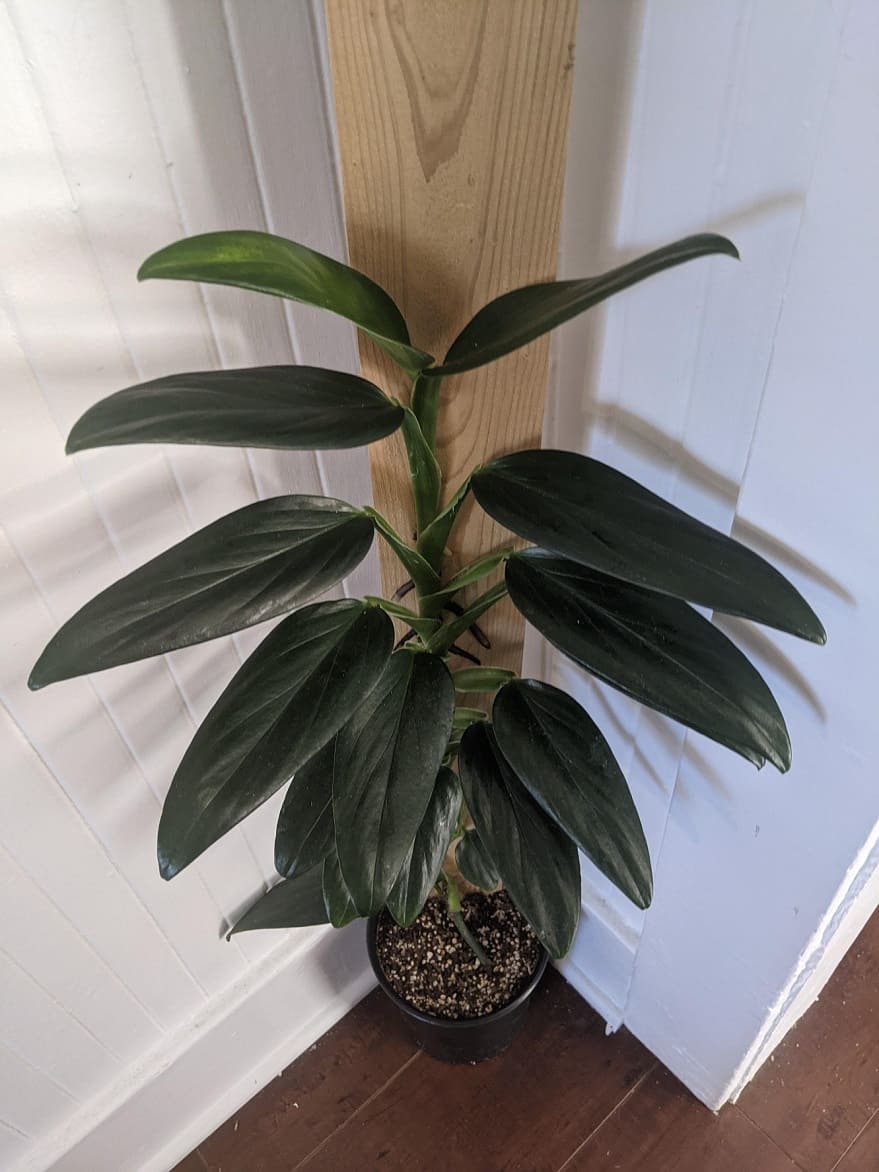
In a Hanging Basket
Allow the vines to cascade downward for a lush, waterfall effect. This is particularly effective in macramé hangers or from high shelves where the trailing vines can be appreciated.
Learn How to Hang Plants with Ease: A Complete Beginner’s Guide
On a Plant Shelf
The contrasting colors of the variegated leaves make this plant a perfect “thriller” in a shelf arrangement. I’ve found it pairs beautifully with dark, solid-colored pots that make the variegation pop.
Complementary Plants
For a cohesive collection, consider pairing Monstera Standleyana with:
- Baltic Blue Pothos or Global Green Pothos
- Scindapsus Moonlight
- Philodendron varieties, especially variegated types
- Other Monstera species for a genus collection
Learn How to Care for Manjula Pothos: Tips for Beginners & Pros
Frequently Asked Questions
- Does Monstera Standleyana develop holes in the leaves like other Monsteras?
No, despite being a true Monstera, the Standleyana doesn’t develop fenestrations (holes or splits) in its leaves, even with maturity.
- How toxic is Monstera Standleyana to pets and children?
Like other members of the Araceae family, it contains calcium oxalate crystals that can cause irritation if ingested or if the sap contacts skin. Keep it away from curious pets and children.
- How much should I pay for a Monstera Standleyana?
Prices vary by location and size, but generally:
- Standard variety: $30-60 for a healthy, established plant
- Albo or Aurea varieties: $50-100+ depending on the extent of variegation
- Why is my Monstera Standleyana not climbing?
The aerial roots of Standleyana aren’t as strong as those of some other Monstera species. You’ll likely need to help it by attaching vines to the support using plant-safe ties or clips.
- Can Monstera Standleyana be grown outdoors?
Yes, but only in USDA zones 9-11 where temperatures don’t drop below 50°F (10°C). Otherwise, it’s best kept as a houseplant or moved outdoors only during warm summer months.
- Does Monstera Standleyana flower indoors?
It rarely flowers indoors, but with age and optimal conditions, it may produce the spadix and spathe typical of the Araceae family. The flowers aren’t particularly showy.
Final Thoughts
After three years of growing Monstera Standleyana, I’ve come to appreciate not just its striking appearance but also its resilience and adaptability. While it has a few quirks—like its tendency to produce runners in insufficient light—it’s generally a forgiving plant that rewards proper care with steady growth and beautiful foliage.
What I love most about this plant is how it continues to surprise me with the unique variegation pattern on each new leaf. Every unfurling leaf is like unwrapping a gift, with its own distinct personality and charm.
Whether you’re new to houseplants or an experienced collector, Monstera Standleyana offers a perfect balance of exotic beauty and manageable care requirements.
Have you added a Monstera Standleyana to your collection yet? If not, I hope this guide has inspired you to consider this elegant climbing beauty. And if you already have one, I’d love to hear about your experiences growing this fascinating plant!
